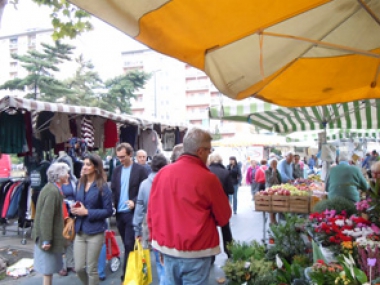Renewing old markets, a tool for cities
Edited on
14 February 2017Markets are as old as cities. In each city, markets are organised according to each country's culture. In all cases, though, they create meeting spaces, business and jobs and they have wide-ranging potential when it comes to implementing sustainability policies and new trends.

What came first, markets or cities? This question is similar to whether it was the egg or chicken that came first. Everyone knows that markets are as old as civilization itself, especially anthropologists, who have written extensively about this. My teacher Jesus Contreras told me 30 years ago that in the nineteenth century, markets were places where people met and organized weddings, but these days weddings are at function halls and discos.
Today the image of markets as places that young people don’t use anymore is beginning to change and maybe some marriages might even get planned here again:-). Going to a market is becoming trendy in some places. If you visit Camden Market in London the average age of users is quite low, especially during the summer when it is overrun by thousands of students studying English in the UK and other tourists. One of the goals there is to recover Camden’s local buyers. But in Barcelona, where markets are primarily for food, young couples (30 years old and up, because their mothers would get the food shopping until then) flood markets on Saturday mornings shopping for food because they are concerned about healthy eating, quality, Zero km products and personalized services from traders.
In every city in every country, markets have different approaches based on what is inherent in their culture in an anthropological sense. During a recent visit to London’s markets organized by Cross River Partnership, an URBACT MARKETS project partner, we saw the peculiartities of these markets. They are usually privately run, part of public space recovery initiatives, creating commercial business concepts defined ‘authentic’ and real estate projects. Behind this last private sector initiative, the public system has a ‘laissez faire’ attitude aimed at not hindering initiatives that can generate wealth in the surrounding areas, unless it causes problems for the community, and that the benefits include urban planning, services, employment, etc.
Meanwhile, in southern Europe market management is usually from the public sector. Torino, Athens and Barcelona are examples, with strong involvement from local government in terms of facilities and traders to ensure that this service is considered a basic part of the food supply, and which at the same time brings other benefits for urban organization. Public-private partnerships in these cases is weighted in favour of the public sector, while in the Anglo-Saxon world, it is the reverse. Probably, moving these two extremes closer together would be beneficial for both models.
But the differences are not only about the degree of public and private engagement, they are also about the type of market we want. In southern Europe, the culture of food and gastronomy is part of everyday life and the main markets have at their hearts. We have not seen the same in London and Wroclaw where food is not the main product of markets. Building selling points around the idea of health benefits in food, the benefits of local produce and km 0 products can also be linked to markets a tools to improve the welfare of those living in cities.
We therefore see very different approaches because of customs and culture, and we could probably refer to Max Weber's theory of Protestant liberalism and the spirit of Catholicism to justify these different social approaches.
What is undeniable is that markets are very useful tools to transform cities, whether from the private or public or mixed approaches: to facilitate the regeneration of neighborhoods and social cohesion, create jobs and strengthen SMEs, distribute products and incorporate and promote sustainable practices, promoting a type of healthy food and lifestyle, etc.
But there are some premises that must be taken into account when initiating a strategy like this:
1- Business must be profitable, in other words, markets must be commercially sustainable.
2- The development and improvements to markets, and consequently also the local environment, must be based on a shared commitment between traders and local government, both in terms of objectives and also actions and funding. We are talking about governance and strategy.
3- Local authorities should consider markets from an integrative perspective, taking it into account urban planning and the implementation of environmental and social improvements, etc. p
Cities are complex ecosystems in which organization and the smooth running and generation of wellbeing form part of many other factors. Markets are tools that allow improvements in many areas. The results of URBACT MARKETS’ final output document will present the benefits and opportunities that markets offer and some examples of good practices in participating ciutas: Attica, Barcelona, Dublin, London, Pecs, Suceava, Turin, Toulouse and Wroclaw.
Watch out for the next episode ... To be continued
Nuria Costa
Lead Partner, URBACT Markets project
 Submitted by Simina Lazar on
Submitted by Simina Lazar on




